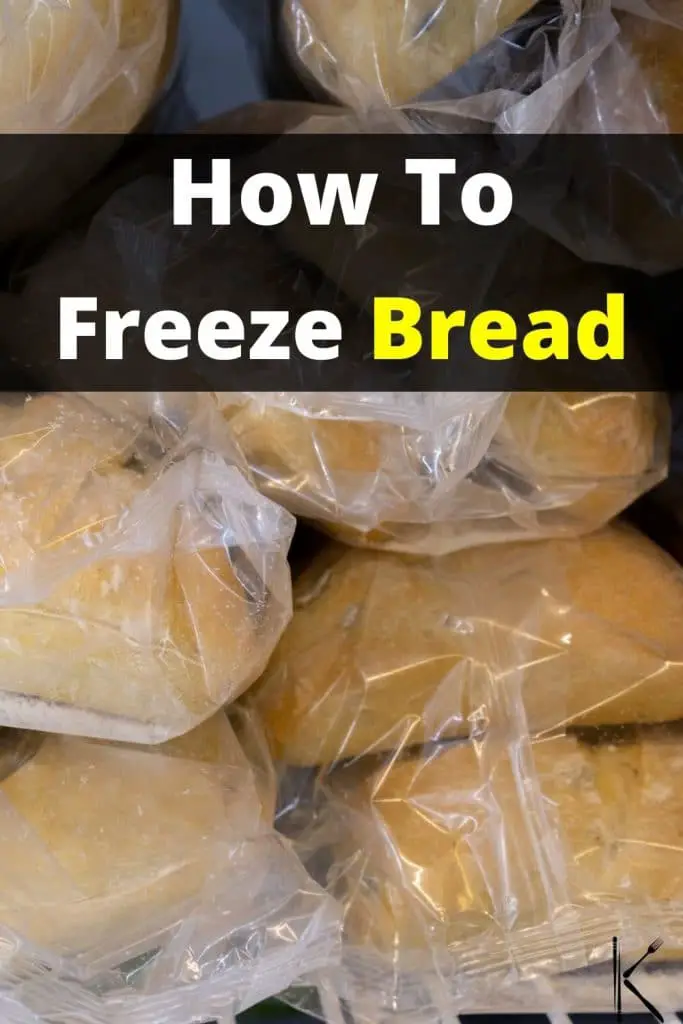Briefly, yes, you can freeze fresh bread in a well-wrapped package, but it may absorb the flavor of other foods.
The taste of butter melting into a thick slice of warm, freshly baked bread is pure comfort. So simple, yet so delicious.
Bread is a staple food worldwide and is incredibly versatile in its uses in both sweet and savory cooking.
Unfortunately, bread already starts to lose moisture just a few hours after baking. This means that bread has a short lifespan and the quality deteriorates quickly. The great thing is, you can keep bread fresh for a few weeks by simply freezing it.
Whether it’s a baguette, sourdough, or bagel, keeping bread frozen is one of the best ways to significantly lengthen its shelf life. This means not a single crumb needs to be wasted.
Here is your full guide to freezing bread successfully.
Can Bread Be Frozen?
Yes, the great news is that bread can be frozen for later use with hardly any noticeable changes in its texture, color, or flavor. To preserve the best quality, freeze the bread while it is still fresh.
If you have an entire loaf that you know you won’t finish within 2 to 3 days, freeze half of it before it starts to go stale.
Whether you are freezing wheat bread, rye, or gluten free loaves, it is imperative to protect the bread from contact with air and moisture in the freezer. The ‘freezer air’ can cause the bread to absorb the flavor of surrounding foods and can result in freezer burn if it is not wrapped sufficiently.
How To Freeze Bread
Step 1: Cool
If you’re freezing freshly baked homemade bread, let the bread cool completely before packaging it. Freezing a warm loaf will damage the consistency of the crumb and spoil the texture of the bread. Condensation of the warm air will cause large ice crystals to form which will cause freezer burn.
Step 2: Slice
Bread can be frozen as a whole loaf or sliced. Slicing the bread before freezing is ideal if you are only going to need a few slices at a time. This way you can remove only the amount you need from the freezer and keep the rest safely stored without worrying about it going to waste.
It is also a good idea to slice bagels before freezing. Doing this allows the bagels to fit into the toaster straight from frozen.
Step 3: Wrap and Seal
If you are freezing a whole loaf, place it into a freezer bag and press all the air out. Seal the bag well ensuring that no air or moisture can enter.
If you do not have a plastic bag big enough for the loaf, wrap the loaf tightly in plastic wrap. Then wrap it again in a layer of aluminum foil. Make sure there are no gaps in the wrapping where air can enter.
If you are freezing sliced bread, it may be a good idea to place a piece of wax paper or freezer paper between the slices. This way they’ll separate easily from one another. Place the slices in a zip lock bag, press out any air, and seal.
Step 4: Label and Freeze
Label the packaging with the date and contents to keep track of how long it has been in the freezer. Place your wrapped bread in the freezer in a place where it is easy to reach and won’t be squashed by other heavier items.
How To Thaw Frozen Bread
Bread can be toasted directly from frozen. That means you can take slices of bread or sliced bagels and put them straight from the freezer into the toaster. Toast the bread for an extra minute or 2 to compensate for the colder temperature.
If you want to thaw rolls, baguettes, or an entire loaf of bread, sliced or unsliced, thaw it on the counter at room temperature.
To reconstitute a ‘just-baked’ crispy crust, sprinkle some water over the bread and toast it in the oven directly on the oven rack. The water droplets will steam in the oven and create a crisp crust. This is the best way to reheat bread.
Breads such as baguettes will need 15 minutes baking time from frozen while full larger loaves may need up to 20 minutes at 350 °F (180 °C).
Types of Bread
Bread takes on many different forms across the world. From fluffy white loaves, flatbreads, dense rye loaves, and long baguettes to wheat-free, sourdough, and seed-loaf versions.
Bread is most commonly made from wheat flour with the addition of yeast allowing it to rise and form air pockets. The wheat flour can be processed white flour or wholewheat. Non-wheat cereals used to make specialty breads include rye, oats, corn/maize, and barley. Other types of bread such as low carb bread, keto bread, coconut and almond bread can also be frozen.
FAQs
Conclusion
Breakfast, lunch, dinner, dessert, or snacks, there is always a place for bread in any meal. Once bread is no longer fresh it can easily be turned into croutons, toast, stuffing, bread pudding, or used as a binder.
Don’t let your bread get to the stage where mold appears. Simply freeze it before it starts to go stale and you’ll have seemingly fresh bread handy at any time.
See more: can you freeze cornbread?

*image by darksoul72/depositphotos









